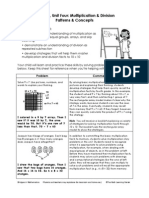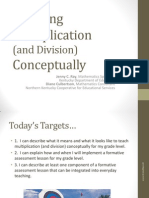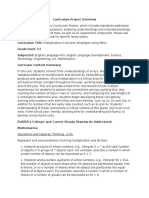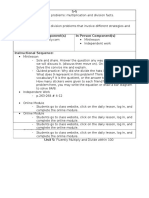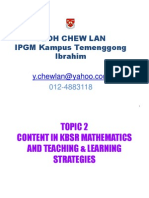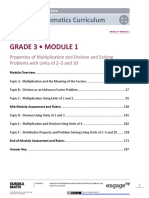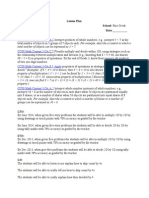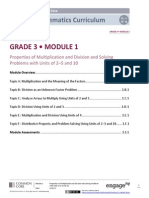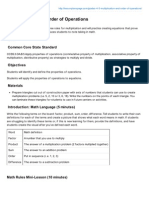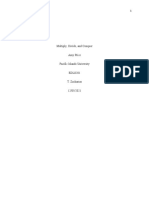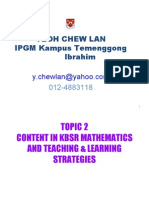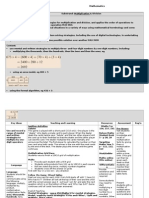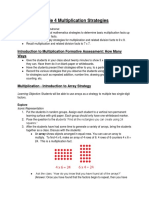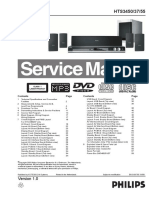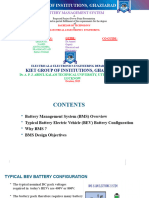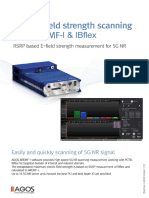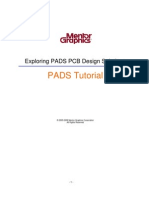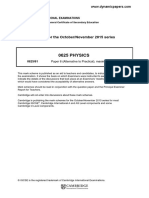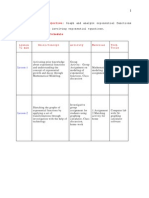Unit 4
Multiplication and Division with Factors of 6, 7, 8, and 9
Unit Summary
In this unit, students will develop understanding of, interpreting, representing, and solving problems with all unknowns in equal groups, arrays/and
measurement quantities situations involving multiplication and division.
Learning target of I can use my understanding of multiplication and the relationship between multiplication and division to represent, interpret, and
unit solve problems involving multiplication and division within 100
Essential understandings Overarching essential questions
Multiplication and division problems with whole numbers can be solved by Which situations the operations of multiplication and division are
using drawings as well as equations. appropriate choices to solve problems?
How can multiplication and division be represented and interpreted?
Why does understanding the properties of multiplication and addition
Multiplication and division have an inverse relationship and can be used to help with the understanding of computational procedures for
solve problems and check answers. multiplication and division, including mental strategies and estimation
strategies, invented algorithms, or general written methods that are
variations of the standard algorithms?
Summative 1. Sarah bought 2 boxes of doughnuts. Each box contained 12 donuts. She shared a total of 7 donuts with her friends. How many
Assessment doughnuts does she have now?
Describe what 2. Clear Creek School is fundraising. They are selling Cookie Dough in tubs.
students will do
and produce to Chocolate Chip Cookie Dough Peanut Butter Cookie Dough
develop evidence Oatmeal Cookie Dough
that will be $3 a tub
$5 a tub $4 a tub
evaluated using the
scoring criteria
a. Jill sold 2 tubs of Oatmeal Cookie Dough.
How much did she raise? $ ____________________________
b. Joe sold 4 tubs of Peanut Butter Cookie Dough and 4 tubs of Chocolate Chip Cookie Dough.
How much money did he raise in all? $ _________________________________
1
� Show how you figured it out.
c. Jade sold only Peanut Butter Cookie Dough. She raised $32.
How many tubs did she sell? __________________ tubs
Show how you figured it out.
d. Jermaine’s mother loves oatmeal cookies. She has $20. to spend.
What is the greatest number of tubs of Oatmeal Cookie Dough she can buy?
__________________________ tubs
Explain how you figured it out.
Evidence of student learning
Criteria for assessment
Concept investigate addition and multiplication table in search of patterns.
use properties of operations (e.g., commutative and distributive properties) as strategies to multiply and divide.
Multiplication and
Division use the distributive property as a strategy to work with products of numbers they know to solve products they do not know. For
example, to find the product of 7 × 8, students might decompose 7 into 5 and 2 and then multiply 5 × 8 and 2 × 8 to arrive at
40 +16, or 56.
Problem solving / use concrete objects, pictures, or drawings to help them conceptualize and solve problems such as these: “Jim purchased 5
modeling packages of muffins. Each package contained 3 muffins. How many muffins did Jim purchase?” or “Describe another situation
where there would be 5 groups of 3 or 5 x 3.”
represent mathematical situations in multiple ways such as using sets of counters, number lines to skip count and relate to
multiplication and arrays/area models in solving problems involving multiplication and division.
consider the available tools (including drawings or estimation) when solving a mathematical problem and decide when particular
tools might be helpful. For instance, they may use square tiles or graph paper to find all the possible rectangles that have a
given perimeter.
Communicate construct arguments using objects, pictures, or drawing.
reasoning
explain and discuss why the patterns found in addition and multiplication tables make sense and how they are related to
properties of operations (e.g., why is the multiplication table symmetric about its diagonal from the upper left to the lower
right?)
2
� recognize that a number represents a specific quantity.
specify units of measure and to state the meaning of the symbols they choose. For instance, when calculating the area of a
rectangle they record the answer in square units.
calculate efficiently and accurately.
Prior Knowledge At end of Grade 2, Students should be able to
• Explain that the three digits of a three-digit number represent amounts of hundreds, tens, and ones.(2.NBT.1)
• Use concrete objects to determine whether a group of up to 20 objects is even or odd. (2.OA.3)
• Write an equation to express an even number as a sum of two equal addends. (2.OA.3)
• Use concrete and pictorial representations and repeated addition, determine the total number of objects in a
rectangular array with up to 5 rows and up to 5 columns. (2.OA.4)
• Write an equation to express the total number of objects in a rectangular array with up to 5 rows and up to 5 columns
as a sum of equal addends. (2.OA.3)
• Fluently add and subtract within 100, using strategies based on place value, properties of operations, and/or the
relationship between addition and subtraction. (2.OA.1)
• Measure lengths of several objects to the nearest whole unit. (2.MD.9)
• Create a line plot where the horizontal scale is marked off in whole-number units to show the lengths of several
measured objects. (2.MD.9)
• Create a picture graph and bar graph to represent data with up to four categories. (2.MD.10)
• Using information presented in a bar graph, solve simple “put-together,” “take-apart,” and “compare” problems.
(2.MD.10)
• Using pictographs and "yes-no" charts, analyze data to predict an outcome. (2.MD.10)
In Unit 2 students Multiplied and Divided with Factors of 2, 3, 4, 5, and 10
3
� Progression of learning
I can use my
understanding of
solve two-step word
use multiplication multiplication and the
and division within problems using the
four relationship between
understand and identify arithmetic 100 to solve word
use use an area operations and multiplication and division
apply the patterns and explain problems involving
model to represent these
decomposition
commutative the equal groups, to represent, interpret,
of factors of understand and problems using
and associative apply the
patterns using arrays, and and solve problems
ten and properties of measurement equations with a
property distributive involving multiplication
properties operations. quantities and model letter standing for
of property of and division within 100.
of operations the relationship the unknown
multiplication multiplication (as
to multiply quantity by using
as a strategy a strategy) to using bar modeling,
one-digit I can describe number line, arrays, tape diagrams.
to multiply multiply and
whole patterns in addition etc
when solving divide to solve
numbers and multiplication
word problems. word problems.
by multiples charts. I can determine the
.
of ten (10 – first step in a two-
. I can explain I can represent a
90. step word problem
I can explain and patterns when two-step word
I can explain
represent adjusting addends. problem with
and represent I can determine the
distributive models, pictures,
I can multiply the I can explain that second step in a
property and equations.
one-digit commutative doubling a factor two-step word
numbers by 10. property doubles the product. problem
I can apply I can write an
I can explain properties to equation using a
I can explain I can explain that a I can represent a
and represent recall basic facts letter for the
how factor can be two-step word
the associative or multiply with unknown number.
multiplication decomposed and the problem with models,
property multiples of 10.
with multiples partial products can pictures, and
of 10 is related be put back I can determine if equations
to basic facts. together. a solution to a
two-step problem I can determine if a
How is the How does using I can explain is reasonable.
I can use an area model solution to a two-
commutative patterns in addition
place value help understand step problem is
property of
and properties multiplication I can explain reasonable.
multiplication
to multiply and division? patterns in
evident in an
multiples of 10 multiplication What strategies
array model,
can be used to How do the
but not in
solve properties of
subtraction or
How is Why does place multiplication operations enable
division? 3.OA.5
multiplying value play a problems? you to solve
by ten significant role problems?
related to when using the
place value? 3.OA.5 properties of
3.OA.8
operations to solve 3.OA.8
problems?
3.NBT.3
3.OA.9
4
�Learning Intention 1 use decomposition of factors of ten and properties of operations to multiply one-digit whole numbers by multiples of ten (10 –
90) and can recognize and explain patterns when multiplying by multiples of ten.
Standard 3.NBT.3 Multiply one-digit whole numbers by multiples of 10 in the range 10–90 (e.g., 9 × 80, 5 × 60) using strategies based on
place value and properties of operations.
Common Formative 1. Describe the pattern you see when you multiply 3 x 4 and then 3 x 40.
Assessment 2. How are the products of 5 x 5 and 5 x 50 similar? How are they different?
3. How does multiplying 10 x 8 help you to solve 9 x 8?
4. Explain how multiplying by multiples of 10 is similar to multiplying by one-digit numbers.
5. Complete.
4 x 70 = __________ 50 x 6 = __________ 2 x 70 = __________
20 x 8 = __________ 9 x 90 = __________ 80 x 7 = __________
Create two different equations using a one-digit whole number and a
multiple of ten to equal 240.
__________ x _________ = 240 __________ x __________ = 240
Learning Intention understand and apply the commutative and associative property of multiplication as a strategy to multiply when solving word
2 problems.
Standard 3.OA.5 Apply properties of operations as strategies to multiply and divide (students need not use formal terms for these
properties).
Common Formative 1. Do the 2 arrays of cans show the commutative property?
Assessment Tell how you know.
5
�2. Explain how the associative property can help you better solve the problem 2 x 8 x 5?
3.
6
�Learning Intention use an area model to understand and apply the distributive property of multiplication (as a strategy) to multiply and divide to
3 solve word problems.
Standard 3.OA.5 Apply properties of operations as strategies to multiply and divide (students need not use formal terms for these
properties).
Common Formative 1. Eric says he has more donuts because his mom bought six boxes of four donuts each. Samantha says that she has more
Assessment donuts because her mom bought four boxes, each with six donuts. Who is correct? Explain your thinking.
2. Melissa needs to solve 24 x 4 in her head. What strategy should she use?
3. Danielle is trying to multiply a strand of numbers (6 x 3 x 5) in her head but is having trouble keeping them organized in
her head. Describe a strategy that she can use to solve the problem.
4. Malcolm multiplied 3 numbers together and got 24. What 3 numbers could he have multiplied? What strategy did you
use to figure the numbers out?
5. Solve 8 x 7 using the distributive property. Could you distribute a different factor or distribute the same factor a
different way?
Learning Intention identify arithmetic patterns and explain the patterns using properties of operations.
4
Standard 3.OA.9 Identify arithmetic patterns (including patterns in the addition table or multiplication table), and explain them using
properties of operations. For example, observe that 4 times a number is always even, and explain why 4 times a number can be
decomposed into two equal addends.
Common Formative Below is a table showing how to add numbers from 1 to 3 :
Assessment
7
�Cut out the table and fold it over the dotted line. Notice that the blue squares match up and so do the orange squares. Notice
that the squares that match up have the same numbers in them. We say that the squares that match up when you fold along
the line are "mirror images" of each other.
The table below shows how to add numbers from 1 to 9. Two squares are shaded blue and two are green:
a. Are the blue squares mirror images of each other? Explain why the numbers in the blue squares are equal.
b. Are the green squares mirror images of each other? Explain why the numbers in the green squares are equal.
c. Shade the rest of the mirror image squares with the same color. Why are the mirror image numbers always equal ?
8
�Learning Intention use multiplication and division within 100 to solve word problems involving equal groups, arrays, and measurement quantities and
5 model the relationship using bar modeling, number line, arrays, etc
Standard 3.OA.8 Solve two-step word problems using the four operations. Represent these problems using equations with a letter standing
for the unknown quantity. Assess the reasonableness of answers using mental computation and estimation strategies including
rounding.
Common Formative 1. About how many days have you been in school? Tell how you estimated and what mathematical operations you used.
Assessment 2. Ben has two cats. Each cat eats one can of wet cat food per day. Cat food is sold with 24 cans in a case. Ben wants to
buy enough cat food for two weeks. If he buys one case is this enough cat food? Explain your answer.
3. The answer is 42. What is the question?
4. There are 61 third-grade students in Amy’s school. 19 of the them are in the library. How many are left in their
classrooms? If each classroom holds about 20 students, how many classrooms are likely being used?
5. Andrea had some markers. When she puts them in groups of 3, there was 1 left over. When she put them in groups of 4,
there were 3 left over. If she had fewer than 20 markers, how many could she have had?
6. There were 531 building blocks in a tub. Jackson used 240 to build a truck and 80 to build a cart. He used the rest of
the blocks to build a house. Write an equation that someone could use to find the number of blocks used to build the
house. Use the letter h to represent the number of blocks used to build the house.
Learning Intention solve two-step word problems using the four operations and represent these problems using equations with a letter standing for
6 the unknown quantity by using tape diagrams.
Standard 3.OA.8 Solve two-step word problems using the four operations. Represent these problems using equations with a letter standing
for the unknown quantity. Assess the reasonableness of answers using mental computation and estimation strategies including
rounding.
Common Formative 7. About how many days have you been in school? Tell how you estimated and what mathematical operations you used.
Assessment 8. Ben has two cats. Each cat eats one can of wet cat food per day. Cat food is sold with 24 cans in a case. Ben wants to
buy enough cat food for two weeks. If he buys one case is this enough cat food? Explain your answer.
9. The answer is 42. What is the question?
10. There are 61 third-grade students in Amy’s school. 19 of the them are in the library. How many are left in their
classrooms? If each classroom holds about 20 students, how many classrooms are likely being used?
11. Andrea had some markers. When she puts them in groups of 3, there was 1 left over. When she put them in groups of 4,
there were 3 left over. If she had fewer than 20 markers, how many could she have had?
12. There were 531 building blocks in a tub. Jackson used 240 to build a truck and 80 to build a cart. He used the rest of
the blocks to build a house. Write an equation that someone could use to find the number of blocks used to build the
house. Use the letter h to represent the number of blocks used to build the house.
Resources Tools for NC Teachers
9
� Match Fish Tank Multiplication and Division Part 2
Georgia Unit 2 Multiplication and Division
HCPSS Scope and Sequence
SCUSD Unit 2 Multiplication and Division
Utah Curriculum Resources
Reflection
10









